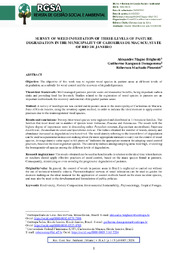Survey of weed infestation of three levels of pasture degradation in the municipality of Cahoeiras de Macacu, state of Rio de Janeiro.
Survey of weed infestation of three levels of pasture degradation in the municipality of Cahoeiras de Macacu, state of Rio de Janeiro.
Author(s): BRIGHENTI, A. M.; DONAGEMMA, G. K.; PIMENTEL, R. M.
Summary: Objective:The objective of this work was to register weed species in pasture areas at different levels of degradation, as a subsidy for weed control and the recovery of degraded pastures.Theoretical framework:Well-managed pastures provide socio-environmental benefits, being important carbon sinks and providing food for livestock. Studies related to the registration of weed species in pastures are an important tool towards the recovery and renewal of degraded pasture areas.Method:A survey of weed species was carried out in pasture areas in the municipality of Cachoeiras de Macacu, State of Rio de Janeiro, using the inventory square method, in order to indicate the ideal moment to apply control practicesdue to the main registered weed species.Results and conclusions: Twenty-three weed species were registered and distributed in 11 botanical families. The families that most stood out in number of species were: Fabaceae, Poaceae and Asteraceae. The weeds with the highest degree of importance were in descending order: Paspalum notatum, Eupatorium maximilianii, Imperata brasiliensis, Desmodiumincanumand Sporobolus indicus. The values obtained for number of weeds, density and abundance increased as degradation levels evolved. The weed density referring to the lowest level of degradation can be used as a parameter in decision-making about the most appropriate moment to carry out the control of weed species. Average density value equal to 6.0 plants m-2indicates the appropriate moment for adopting weed control practices, based on the main registered species. The similarity indices amongsamplingareas werehigh, evidencing the homogeneity of species among the different levels of degradation.Research implications:The results obtained can be used as benchmarks in relation to the ideal time when farmers or ranchers should apply effective practices of weed control, based on the main species found in pastures. Consequently, minimizing or even avoiding the progressive degradation of pastures.Originality/value: In general, the control of weeds in pasture areas in Brazil is neglected or carried out without the use of technical-scientific criteria. Phytosociological surveys of weed infestation can be used as guides for decision-making on the ideal moment for the application of control methods based on the main incident species, and may also be used in the development and formulation of public policies.
Publication year: 2024
Types of publication: Journal article
Unit: Embrapa Dairy Cattle
Observation
Some of Embrapa's publications are published as ePub files. To read them, use or download one of the following free software options to your computer or mobile device. Android: Google Play Books; IOS: iBooks; Windows and Linux: Calibre.
Access other publications
Access the Agricultural Research Database (BDPA) to consult Embrapa's full library collection and records.
Visit Embrapa Bookstore to purchase books and other publications sold by Embrapa.

